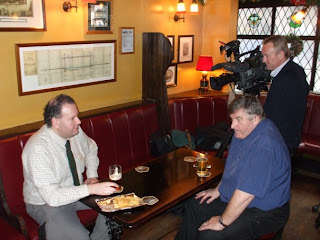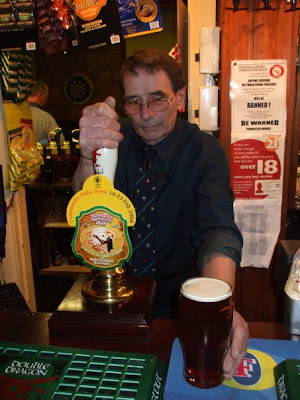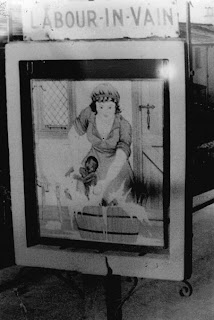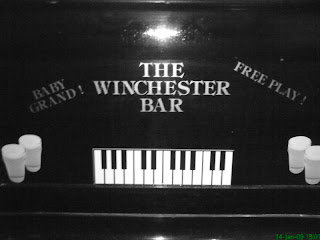Brew Wales, Mythical Pub Award
This award is for the biggest amount of non-facts, out and out lies and mistruths ever written about a pub.
The winner is, The Skirrid Mountain Inn, Llanfihangel Crucorny, Monmouthshire.
So much rubbish has been published about this pub over the years it's difficult to know where to start debunking the rumours and myths so let's start chronologically.
Western Mail, Country Supplement 01.10.96. Reporter: Kate Smout.
“A building is believed to have been on this site since Roman times”.
FACT – no Roman artifacts have been recorded here. If they have been found then they found there way to Ebay before the local museum recorded them.
“Records show that courts were held in the main room of the pub, known as the Millbrook alehouse as early as 1110”.
FACT – no records exist from such a date. Every reference to these supposed records does not mention them by name, if they did then these supposed records could be read by everyone. Also the Skirrid pub is on a hill, if somewhere known as The Millbrook existed it is more likely to be on the river Honddu than higher up the hill.
“Local brothers James and John Crowther were tried and sentenced at the inn. James got nine months for robbery with violence. John's sheep stealing activities cost him his life”.
FACT Both have modern names for 1110 and in the days of branding and amputation for criminal activities, along with trial by ordeal, it seems a bit strange that James gets sentenced to nine months in an era where prisons did not exist for punishment but merely as holding places before trial, sentence and execution. Again there is not any documented evidence to support this pub myth, but in different accounts of this myth, sometimes it is James who was hung.
“The existing stone structure is Elizabethan”
FACT So having argued the point that the pub dates back to Norman times in 1110, the Western Mail now asserts that it only goes back as far as Elizabethan times. Let's reach for Pevsner, or in our case John Newman, the Buildings of Wales, who states, “It is a remarkably complete mid- to late 17th Century building”. That dates it 1640-1700. The myths are starting to break down.
“Owain Glyndwr rallied his troops from the mounting block in the courtyard”
FACT The stonework of the mounting block is contemporary with that of the inn, mid- to late 17th Century. Owain Glyndwr was long since dead and buried over the border in Herefordshire before the Skirrid was built.
The reporter, Kate Smout, continues to spout more rubbish about the pub such as “time-stained granite walls”.
FACT the walls are the local Devonian Old Red Sandstone, there is no granite in Monmouthshire and certainly none used in the building of this pub.
It's not just the National Newspaper of Wales that has published such rubbish that pertain to be facts about this pub. The pub itself has published a leaflet full of these myths.
This goes even further by saying that the mounting stone has been used by Princes of Wales and Kings of England!
FACT No evidence exists of Kings arriving or leaving from the pub on horseback, or even visiting the pub.
The leaflet claims the wood paneling and beams in the dinning room came from an Elizabethan ship.
FACT Why import wood 40 miles inland when there is a perfectly good forest nearby. Carpenters from either Abergavenny, Hereford or Monmouth would have been able to work this into the finished paneling we see today.
I'm indebted to an annoying, badly written and with even worse photographs, little book, Strangest Pubs in Britain, for claiming that 1800 people were hanged in the Skirrid over the years. Not even the booklet published by the pub claims this figure, they go for a modest 180, although they add the rider “no exact or positive records exist”.
FACT No proof is even offered for this myth but it is accepted as fact, one website even claims that the 180 were executed in the aftermath of the Monmouth Rebellion.
FACT The Monmouth Rebellion involved the Duke of Monmouth and the battle of Sedgemoor was in Somerset, as was the aftermath when Judge Jeffreys tried the conspirators.
Claims are made that the Skirrid was used as a courthouse.
FACT No records exist for any criminal courts being held here. Local Manorial courts which dealt with the day-to-day administration of the lands, boundary disputes and the election of the Ale-Taster may well have been held here as the pub was owned by the local landowners, the Neville family.
The booklet says that the marks on the stairwell are from the rope that was used to hang people.
FACT Since the pub dates from 1640 and there has not been one documented execution in the pub, the marks on the stairwell could easily be put down to scratches made whilst moving furniture.
One previous landlord went as far as to have a mannequin hanging from the stairwell. Popular with Ghost Tourists and the exceedingly camp ghost hunting TV programmes.
The booklet mentions that behind the Elizabethan plasterwork is the inscription JHT 1306.
FACT If the date is behind the Elizabethan plasterwork how does anyone know it's there and if it dates from that time it should be in Roman not Arabic numerals? If you are going to make a pub myth at least get the typeface right – clue it's MCCCVI
Quote from the pub pamphlet, “The Skirrid Inn is the oldest public house within the borders of the Principality of Wales and ranks among the foremost claimants to the title of the oldest public house in Great Britain”.
FACT The first mention of the Skirrid as a licensed house was in 1859, when it was described as a beer house. This meant it was not even a fully licensed pub and according to John Eisel and Frank Bennett in their book, the Pubs of Hay-on-Wye and the Golden Valley, it was unlikely to predate the 1830 Beer Act.
According to local historian Fred Hando, writing in 1958, “No relic survives which would date the present building to before 1640.”
So there we have it, the Skirrid Inn dates from the earliest 1640 and probably became a pub in 1830. Hardly the “oldest pub in Wales”.
Pubs with a better claim to the title in Wales:
Cross Keys Inn, Swansea, 1300s
Kings' Arms, Abergavenny, 1500s
Murenger House, Newport, 1520s
Old Swan, Llantwit Major 1500s
Plough & Harrow, Monknash 1383
Duke of Wellington, Cowbridge , was the Half Moon, 1500s
Old House, Llangynwydd, 1147
Hanbury Arms, Caerleon, 1560s, though the tower is Norman!
Red Lion, Llanafan Fawr, 1400s
















